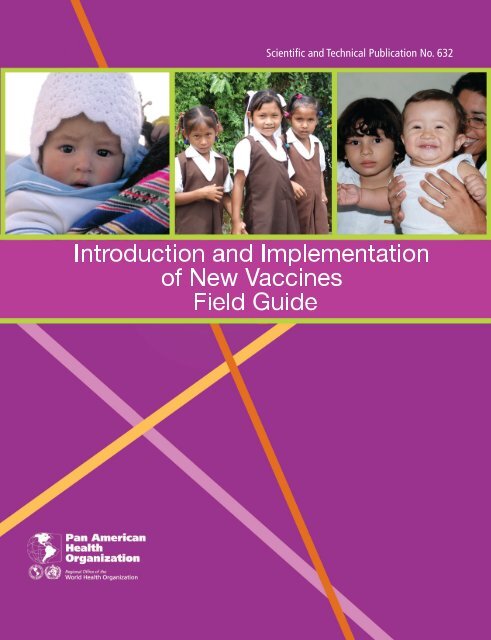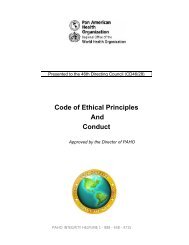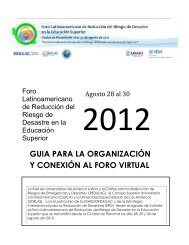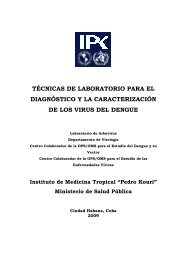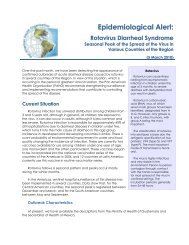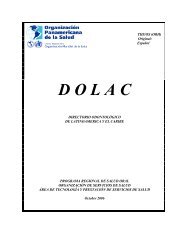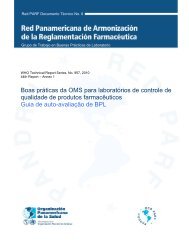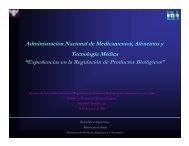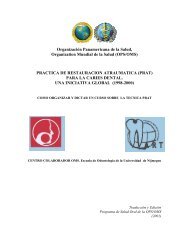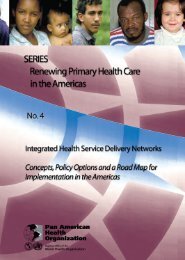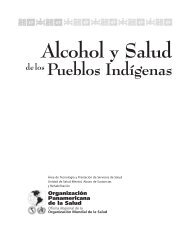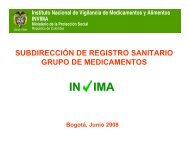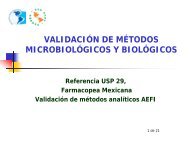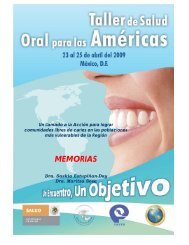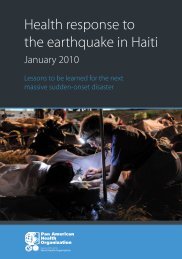Introduction and implementation of new vaccines: Field Guide
Introduction and implementation of new vaccines: Field Guide
Introduction and implementation of new vaccines: Field Guide
You also want an ePaper? Increase the reach of your titles
YUMPU automatically turns print PDFs into web optimized ePapers that Google loves.
Scientific<strong>and</strong>TechnicalPublicationNo.632<br />
<strong>Introduction</strong><strong>and</strong>Implementation<br />
<strong>of</strong>New Vaccines<br />
<strong>Field</strong><strong>Guide</strong>
<strong>Introduction</strong><br />
<strong>and</strong> Implementation<br />
<strong>of</strong> New Vaccines<br />
<strong>Field</strong> <strong>Guide</strong><br />
Scientific <strong>and</strong> Technical Publication No. 632<br />
PAN AMERICAN HEALTH ORGANIZATION<br />
Regional Office <strong>of</strong> the<br />
WORLD HEALTH ORGANIZATION<br />
525 Twenty-third Street, N.W.<br />
Washington, DC 20037<br />
2010
Also published in Spanish under the title:<br />
Introducción e implementación de nuevas vacunas: guía práctica<br />
ISBN 978-92-75-31632-0<br />
PAHO HQ Library – Cataloging in Publication<br />
Pan American Health Organization<br />
<strong>Introduction</strong> <strong>and</strong> <strong>implementation</strong> <strong>of</strong> <strong>new</strong> <strong>vaccines</strong>: <strong>Field</strong> <strong>Guide</strong><br />
Washington, D.C., PAHO © 2010 (Scientific <strong>and</strong> Technical Publication No.632)<br />
ISBN 978-92-75-11632-6<br />
I. Title II. Series<br />
1. VACCINES – norms<br />
2. IMMUNIZATION – methods<br />
3. IMMUNIZATION PROGRAMS – organization <strong>and</strong> administration<br />
4. SURVEILLANCE – norms<br />
5. CONTROL OF COMMUNICABLE DISEASES – methods<br />
6. PUBLIC HEALTH<br />
NLM–QW805<br />
This guide has been prepared by the Family <strong>and</strong> Community Health Area (FCH)/<br />
Immunization Unit (IM) <strong>of</strong> the Pan American Health Organization.<br />
Coordination:<br />
Drafting/Adaptation:<br />
Lúcia Helena de Oliveira, FCH/IM, PAHO<br />
Ida Berenice Molina, Ministry <strong>of</strong> Health, Honduras<br />
Gladys Ghisays, FCH/IM, PAHO<br />
Revision/Collaboration: Alba María Ropero, FCH/IM, PAHO<br />
Carolina Danovaro, FCH/IM, PAHO<br />
Cuauhtémoc Ruiz Matus, FCH/IM, PAHO<br />
Jon Andrus, FCH/IM, PAHO<br />
Maria Luiza de Marilac, Ministry <strong>of</strong> Health, Brazil<br />
Merle Lewis, FCH/IM, PAHO<br />
Nancy Vasconez, Ministry <strong>of</strong> Health, Ecuador<br />
Nelly Quiroz, Ministry <strong>of</strong> Health, Panama<br />
Víctor Gómez Serna, FCH/IM, PAHO<br />
The Pan American Health Organization welcomes requests for permission to reproduce or translate its<br />
publications, in part or in full. Applications <strong>and</strong> inquiries should be addressed to the Publications Program,<br />
Pan American Health Organization, Washington, D.C., U.S.A., which will be glad to provide the latest<br />
information on any changes made to the text, plans for <strong>new</strong> editions, <strong>and</strong> reprints <strong>and</strong> translations already<br />
available.<br />
© Pan American Health Organization (2010)<br />
Publications <strong>of</strong> the Pan American Health Organization enjoy copyright protection in accordance with<br />
the provisions <strong>of</strong> Protocol 2 <strong>of</strong> the Universal Copyright Convention. All rights are reserved.<br />
The designations employed <strong>and</strong> the presentation <strong>of</strong> the material in this publication do not imply the<br />
expression <strong>of</strong> any opinion whatsoever on the part <strong>of</strong> the Secretariat <strong>of</strong> the Pan American Health Organization<br />
concerning the status <strong>of</strong> any country, territory, city, or area or <strong>of</strong> its authorities, or concerning the<br />
delimitation <strong>of</strong> its frontiers or boundaries. The mention <strong>of</strong> specific companies or <strong>of</strong> certain manufacturers’<br />
products does not imply that they are endorsed or recommended by the Pan American Health Organization<br />
in preference to others <strong>of</strong> a similar nature that are not mentioned. Errors <strong>and</strong> omissions excepted, the<br />
names <strong>of</strong> proprietary products are distinguished by initial capital letters.
CONTENTS<br />
About the immunization field guides............................... v<br />
Acronyms.................................................... vii<br />
Preface....................................................... ix<br />
1. <strong>Introduction</strong> ............................................... 1<br />
2. Decision-making criteria for the introduction <strong>of</strong> <strong>new</strong> <strong>vaccines</strong> ...... 3<br />
2.1 Overview ................................................... 3<br />
2.2 Political <strong>and</strong> Technical Factors .................................. 3<br />
2.3 Feasibility <strong>and</strong> Scheduling .................................... 10<br />
2.4 Decision-making ............................................ 11<br />
3. Implementation: plan for the introduction <strong>of</strong> <strong>vaccines</strong> ............ 13<br />
3.1 Background <strong>and</strong> Development <strong>of</strong> Immunization Program ........... 13<br />
3.2 Technical Justification for <strong>Introduction</strong> .......................... 13<br />
3.3 Objectives <strong>and</strong> Goals ........................................ 13<br />
3.4 Scope <strong>of</strong> Application <strong>and</strong> Target Population ...................... 13<br />
3.5 Selection <strong>of</strong> <strong>Introduction</strong> Strategy .............................. 14<br />
3.6 Activities by Component. ..................................... 14<br />
3.7 Cost <strong>of</strong> the Plan ............................................ 18<br />
3.8 Timetable ................................................. 18<br />
3.9 Evaluation ................................................. 19<br />
4. Impact assessment ........................................... 21<br />
References ................................................... 23<br />
Bibliography ................................................. 25<br />
iii
iv • PAN AMERICAN HEALTH ORGANIZATION<br />
ANNEXES<br />
Annex 1. Aspects to Be Considered When Introducing Vaccines:<br />
Examples <strong>of</strong> Application. .................................. 27<br />
Annex 2. Elements for Evaluating Managerial <strong>and</strong> Operational<br />
Capacity <strong>of</strong> the Program to Include New Vaccines .............. 29<br />
Annex 3. Estimating Vaccine Storage Capacity. ........................ 31<br />
Annex 4. Checklist for Evaluating the Vaccine <strong>Introduction</strong> Plan. .......... 35
ABOUT THE IMMUNIZATION FIELD GUIDES<br />
The Exp<strong>and</strong>ed Program on Immunization is viewed as one <strong>of</strong> the most successful<br />
public health experiences in the Americas because it has played a pivotal role in<br />
reducing infant mortality from vaccine-preventable diseases in the Region. In fact,<br />
since the program was launched, our countries stopped the transmission <strong>of</strong> wild<br />
poliovirus in the Region in 1991 <strong>and</strong> interrupted indigenous measles transmission<br />
in November 2002; they also are making significant gains in the battle to eliminate<br />
rubella <strong>and</strong> congenital rubella syndrome. In addition, national immunization programs<br />
are undertaking extraordinary efforts to identify at-risk populations <strong>and</strong><br />
overcome inequities in vaccination. To maintain these advances <strong>and</strong> to cope with<br />
<strong>new</strong> challenges, such as the introduction <strong>of</strong> <strong>new</strong> <strong>vaccines</strong>, partnerships will have to<br />
be strengthened among governments, donor agencies, the private sector, scientific<br />
associations, <strong>and</strong> society as a whole.<br />
To this end, PAHO is promoting the best technical quality by issuing these practical<br />
field guides, which have been prepared by the Immunization Unit in the Family<br />
<strong>and</strong> Community Health Area. The most recent techniques presented in the field<br />
guides, coupled with useful illustrations, will aid health workers in their efforts to<br />
control, eliminate, or eradicate diseases such as poliomyelitis, neonatal tetanus,<br />
yellow fever, diphtheria, pertussis, tetanus, Haemophilus influenzae type b infections,<br />
hepatitis B, measles, <strong>and</strong> rubella. The field guides also include st<strong>and</strong>ardized<br />
methods <strong>and</strong> procedures for conducting epidemiologic surveillance <strong>and</strong> maintain-<br />
ing an up-to-date information system that will make it possible to make timely <strong>and</strong><br />
effective decisions.<br />
These field guides are based on the latest scientific information, <strong>and</strong> they pool<br />
the experience <strong>of</strong> prominent health pr<strong>of</strong>essionals in the field. As a result, they are<br />
particularly suitable for promoting strategies that have already proven to be effective.<br />
The strengthening <strong>of</strong> prevention activities, the reduction <strong>of</strong> health inequities,<br />
<strong>and</strong> the promotion <strong>of</strong> technical expertise in vaccination services were the principles<br />
that guided the preparation <strong>of</strong> the guides.<br />
The Exp<strong>and</strong>ed Program on Immunization, a joint effort by all the countries <strong>of</strong> the<br />
Americas, effectively contributes to the attainment <strong>of</strong> the Millennium Development<br />
Goals.<br />
Mirta Roses Periago<br />
Director<br />
Pan American Health Organization<br />
v
ACRONYMS<br />
AD<br />
CIN<br />
CRS<br />
DALY<br />
DTP<br />
EMEA<br />
EPI<br />
ESAVI<br />
FDA<br />
HepB<br />
Hib<br />
HPV<br />
ICC<br />
IEC<br />
MMR<br />
NCIP<br />
NRA<br />
UNICEF<br />
Auto-disable<br />
Cervical intraepithelial neoplasia<br />
Congenital rubella syndrome<br />
Disability-adjusted life years<br />
Diphtheria-tetanus-pertussis vaccine<br />
European Agency for the Evaluation <strong>of</strong> Medicinal Products<br />
Exp<strong>and</strong>ed Program on Immunization<br />
Event supposedly attributable to vaccination or immunization<br />
United States Food <strong>and</strong> Drug Administration<br />
Hepatitis B vaccine<br />
Haemophilus influenzae type b vaccine<br />
Human papillomavirus<br />
Interagency Coordinating Committee<br />
Information, education, <strong>and</strong> communication<br />
Measles-mumps-rubella vaccine<br />
National Committee on Immunization Practices<br />
National Regulatory Authority<br />
United Nations Children's Fund<br />
vii
PREFACE<br />
New, safe, <strong>and</strong> effective <strong>vaccines</strong> are licensed <strong>and</strong> introduced to the international market<br />
every year. Moreover, advances in biotechnology contribute to the improvement <strong>of</strong><br />
current <strong>vaccines</strong> through <strong>new</strong> formulations <strong>of</strong> the <strong>vaccines</strong> in use. Although they are<br />
available, these <strong>vaccines</strong> have not yet become part <strong>of</strong> the <strong>of</strong>ficial immunization schedule<br />
in many countries. Political authorities must <strong>of</strong>ten make decisions about public<br />
health interventions without the technical facts that would guarantee that their decisions<br />
are the most appropriate, in terms <strong>of</strong> cost-benefit, therefore ensuring the interventions’<br />
sustainability. Before a <strong>new</strong> vaccine is added to an immunization program,<br />
its feasibility <strong>and</strong> sustainability should be evaluated based on previously established<br />
technical criteria in order to determine whether it is actually a public health investment<br />
priority. This field guide has been adapted from the WHO report Vaccine <strong>Introduction</strong><br />
<strong>Guide</strong>lines: Adding a Vaccine to a National Immunization Programme: Decision <strong>and</strong> Implementation<br />
(1). In this guide, PAHO <strong>of</strong>fers a systematic tool with useful suggestions <strong>and</strong> information<br />
for political leaders <strong>and</strong> health authorities that will enable them to make<br />
informed decisions about <strong>new</strong> <strong>vaccines</strong>. The guide is also intended for managers <strong>of</strong><br />
national immunization programs <strong>and</strong> other pr<strong>of</strong>essionals working in this field, as a<br />
tool for resolving technical issues connected with the introduction <strong>of</strong> <strong>new</strong> <strong>vaccines</strong> to<br />
strengthen immunization programs in the Region <strong>of</strong> the Americas. The stages in the<br />
introduction <strong>of</strong> a <strong>new</strong> vaccine are analyzed: 1) Background, 2) Decision-making, 3)<br />
Implementation <strong>of</strong> the decision, <strong>and</strong> 4) Vaccine impact assessment.<br />
ix
1. INTRODUCTION<br />
Immunization is one <strong>of</strong> the most cost-effective public health interventions. Since the<br />
creation <strong>of</strong> the Exp<strong>and</strong>ed Program on Immunization (EPI) in 1974, millions <strong>of</strong><br />
deaths <strong>and</strong> disabilities from vaccine-preventable diseases have been prevented<br />
around the world.<br />
Immunization programs in the Americas have been very successful. In 1970, the<br />
national immunization schedules included four <strong>vaccines</strong> to protect against six diseases<br />
(severe forms <strong>of</strong> tuberculosis, diphtheria, whooping cough, tetanus, poliomyelitis,<br />
<strong>and</strong> measles). During this period, coverage rates were under 10% (2). Later,<br />
systematic vaccination <strong>and</strong> polio eradication campaigns led to greater coverage. In<br />
the 1980s, average coverage <strong>of</strong> 70% to 80% was attained. In the 1990s, most countries<br />
introduced <strong>new</strong> <strong>vaccines</strong>: combination <strong>vaccines</strong> such as the trivalent measlesmumps-rubella<br />
(MMR) vaccine, Haemophilus influenzae type b (Hib) conjugate vaccine,<br />
<strong>and</strong> hepatitis B (HepB) vaccine. The Hib <strong>and</strong> HepB <strong>vaccines</strong> were soon replaced<br />
by a formulation that combined them with the diphtheria-tetanus-pertussis<br />
(DTP) vaccine.<br />
The increase in the number <strong>of</strong> <strong>vaccines</strong> did not affect coverage levels, which continued<br />
to rise. In 2004-2005, the average coverage was 90% (3). The Region <strong>of</strong> the<br />
Americas has been considered a model for the rest <strong>of</strong> the world, since it was the first<br />
Region to eradicate smallpox <strong>and</strong> poliomyelitis. Indigenous transmission <strong>of</strong> measles<br />
has also been eliminated, <strong>and</strong> significant progress has been made in the elimination<br />
<strong>of</strong> rubella <strong>and</strong> congenital rubella syndrome (CRS). Diphtheria <strong>and</strong> whooping cough<br />
have been controlled, <strong>and</strong> neonatal tetanus is no longer a public health problem.<br />
There are <strong>vaccines</strong> against diseases important for international public health that<br />
have not yet been introduced in the routine immunization schedule <strong>of</strong> most developing<br />
countries. Many countries have insufficient financial resources to introduce<br />
these <strong>vaccines</strong> in their immunization programs, <strong>and</strong> use is limited to the private<br />
sector. Consequently, the neediest children cannot access the <strong>new</strong> <strong>vaccines</strong>. This<br />
creates health inequalities <strong>and</strong> inequities between populations, as well as differences<br />
in national vaccination plans.<br />
1
2. DECISION-MAKING CRITERIA FOR THE<br />
INTRODUCTION OF NEW VACCINES<br />
2.1 Overview<br />
Before deciding to introduce a <strong>new</strong> vaccine in the immunization program or change<br />
the route <strong>of</strong> administration or presentation <strong>of</strong> a vaccine, the factors contained in the<br />
Decision-making Criteria for New Vaccine <strong>Introduction</strong> flow chart (Figure 1) should be<br />
considered. The flow chart divides decision-making criteria into two groups. The<br />
first group, Political <strong>and</strong> Technical Factors, <strong>of</strong>fers guidance for the senior authorities<br />
that must make decisions about the advisability <strong>of</strong> introducing the vaccine from the<br />
st<strong>and</strong>point <strong>of</strong> an evidence-based immunization policy. The second group, Feasibility<br />
<strong>and</strong> Scheduling, considers the technical feasibility <strong>of</strong> introducing the vaccine. Although<br />
some criteria in the chart may be more important than others, they should always<br />
lead to a decision, which may be:<br />
• To introduce the <strong>new</strong> vaccine <strong>and</strong> change the current vaccination schedule, or<br />
• Postpone introduction <strong>of</strong> the vaccine until sufficient data has been obtained<br />
on the decision-making criteria proposed for each group.<br />
In order to assist national immunization program managers in the analyses that will<br />
facilitate decision-making, the proposed criteria <strong>and</strong> their rationale are described<br />
below. Some key questions are also posed. The answers to these questions will help<br />
find sustainable responses for decision-making.<br />
2.2 Political <strong>and</strong> Technical Factors<br />
2.2.1 Political <strong>and</strong> Public Health Priorities<br />
Rationale<br />
A disease is a public health priority when:<br />
• There is a high burden <strong>of</strong> disease <strong>and</strong> serious consequences for the health <strong>of</strong> the population;<br />
• The scientific community, political authorities, <strong>and</strong> general population consider it a<br />
serious public health problem; <strong>and</strong><br />
• There is a consensus among opinion-makers, politicians, technical personnel, <strong>and</strong> the<br />
public that this problem should be solved.<br />
3
4 • PAN AMERICAN HEALTH ORGANIZATION<br />
Figure 1. Decision-making Criteria for New Vaccine <strong>Introduction</strong><br />
2.2 Political <strong>and</strong> Technical Factors<br />
2.2.2<br />
Burden<br />
<strong>of</strong> disease<br />
2.2.3<br />
Vaccine safety,<br />
efficacy, <strong>and</strong> quality<br />
2.2.1<br />
Political <strong>and</strong> public<br />
health priorities<br />
New vaccine<br />
2.2.4<br />
Comparison with<br />
other interventions<br />
(including<br />
other <strong>vaccines</strong>)<br />
2.2.5<br />
Economic<br />
<strong>and</strong><br />
financial criteria<br />
2.3 Feasibility <strong>and</strong> Scheduling<br />
2.3.1<br />
Characteristics<br />
<strong>of</strong> vaccine<br />
presentation<br />
2.3.2<br />
Availability <strong>of</strong><br />
vaccine supply<br />
2.3.3<br />
Vaccination<br />
program<br />
performance<br />
2.4 Decision-making<br />
Introduce the<br />
<strong>new</strong> vaccine<br />
Postpone<br />
introduction
INTRODUCTION AND IMPLEMENTATION OF NEW VACCINES • 5<br />
Is the disease to be prevented a political <strong>and</strong> public health priority<br />
The magnitude <strong>and</strong> importance <strong>of</strong> vaccine-preventable disease is one <strong>of</strong> the main<br />
arguments used to justify the setting <strong>of</strong> national health priorities. For example, it can<br />
be demonstrated that the pneumococcal <strong>and</strong> rotavirus <strong>vaccines</strong> currently available<br />
are a political priority in the field <strong>of</strong> health since these agents are responsible for a<br />
significant proportion <strong>of</strong> diseases <strong>of</strong> the respiratory <strong>and</strong> digestive tracts. Moreover,<br />
mortality is higher in children under 5 years in developing countries. It is important<br />
to present rational <strong>and</strong> convincing arguments for the vaccine to political authorities.<br />
These arguments should justify the need to allocate resources, which are usually<br />
limited, to the proposed intervention <strong>and</strong> make it a high priority.<br />
The more important <strong>and</strong> visible a disease is, <strong>and</strong> the more the vaccine is perceived<br />
as a safe <strong>and</strong> effective measure, the greater the acceptance will be. The perception<br />
held by political authorities, the medical community, cooperating agencies, <strong>and</strong> the<br />
general public regarding the vaccine <strong>and</strong> its likely impact should be identified <strong>and</strong><br />
documented by a qualitative evaluation, so that introducing the vaccine will be considered<br />
a priority.<br />
2.2.2 Burden <strong>of</strong> Disease<br />
Rationale<br />
It measures the magnitude <strong>of</strong> the health problem in a given place <strong>and</strong> time in terms <strong>of</strong><br />
incidence, prevalence, disability, hospitalizations, <strong>and</strong> mortality. Knowledge <strong>of</strong> the burden<br />
<strong>of</strong> disease can help target <strong>and</strong> rationalize health investments.<br />
Is the burden <strong>of</strong> disease for the condition to be prevented known<br />
This is an essential question for decision-making. In order to answer it, data are<br />
required on the incidence, prevalence, disability, hospitalizations, <strong>and</strong> mortality<br />
associated with the causative agent in the population <strong>and</strong> the geographical region<br />
or area in which the vaccine is to be introduced. Ideally, these data can be obtained<br />
by public health surveillance systems, special studies, or both.<br />
The current health surveillance systems should compile data about the network<br />
<strong>of</strong> public, private, <strong>and</strong> national health service facilities, as well as incidence, hospitalizations,<br />
disability, <strong>and</strong> mortality related to the disease to be prevented. Surveillancsystem<br />
capacity should be strengthened to include the control <strong>of</strong> other diseases<br />
for which safe <strong>and</strong> effective <strong>vaccines</strong> are already available, even if they have not<br />
been added to the national immunization schedule (e.g., pneumococcal, rotavirus,<br />
influenza conjugate, <strong>and</strong> human papillomavirus [HPV] <strong>vaccines</strong>). The data on these<br />
<strong>vaccines</strong> can be used to measure the impact <strong>of</strong> the intervention, as well as the bur-
6 • PAN AMERICAN HEALTH ORGANIZATION<br />
den <strong>of</strong> disease. If surveillance <strong>of</strong> the disease to be prevented has not been conducted,<br />
it should be, taking the type <strong>of</strong> disease <strong>and</strong> its characteristics (e.g., hospital<br />
surveillance, sentinel surveillance, or other surveillance) into account.<br />
When data from the national surveillance system cannot be used to measure the<br />
burden <strong>of</strong> disease, special studies may be required. Since studies can be expensive,<br />
it is important to insist on obtaining reliable national epidemiological data that can<br />
be used to analyze the burden <strong>of</strong> disease.<br />
PAHO has prepared <strong>and</strong> published six field guides that are essential tools for<br />
combating vaccine-preventable diseases: Neonatal Tetanus Elimination (4), Control <strong>of</strong><br />
Yellow Fever (5), Control <strong>of</strong> Diphtheria, Whooping Cough, Tetanus, Haemophilus influenzae<br />
type b, <strong>and</strong> Hepatitis B (6), Measles Elimination (7), Poliomyelitis Eradication (8), <strong>and</strong> Rubella<br />
<strong>and</strong> Congenital Rubella Syndrome Elimination, in addition to the epidemiological surveillance<br />
guide for rotavirus-related diarrheal diseases. These documents can be<br />
found at http://www.paho.org/english/ad/fch/im/<strong>vaccines</strong>.htm. The World Health<br />
Organization has prepared rapid evaluation instruments, generic surveillance protocols,<br />
<strong>and</strong> guidelines for assessing the burden <strong>of</strong> vaccine-preventable diseases, which<br />
can be very helpful. This material is available at http://www.who.int.<br />
2.2.3 Vaccine Safety, Efficacy, <strong>and</strong> Quality<br />
Rationale<br />
Vaccine safety <strong>and</strong> efficacy is demonstrated during clinical trials conducted under ideal<br />
conditions prior to licensing <strong>and</strong> during the post-marketing surveillance stage.<br />
Although the <strong>vaccines</strong> are safe, events may occur in some cases. When they occur on a<br />
large scale, adverse events are more likely to attract the attention <strong>of</strong> health care workers<br />
<strong>and</strong> the public.<br />
Is the available vaccine safe, effective, <strong>and</strong> <strong>of</strong> good quality<br />
Certain characteristics <strong>of</strong> the vaccine must be demonstrated before it is introduced:<br />
immunogenicity <strong>and</strong> efficacy, duration <strong>of</strong> immunity, interaction with other<br />
antigens, expected adverse events <strong>and</strong> safety, dosage, route <strong>of</strong> administration, pack-<br />
aging, <strong>and</strong> thermostability. It is important to mention that the efficacy <strong>of</strong> the <strong>new</strong><br />
vaccine is measured in clinical trials under ideal conditions, whereas its effectiveness<br />
is measured in the field under actual program conditions.<br />
The <strong>new</strong> vaccine must have been registered by the National Regulatory Authority<br />
(NRA), which is the agency in charge <strong>of</strong> issuing the license that authorizes public<br />
distribution <strong>of</strong> drugs. The NRA is responsible for guaranteeing that the <strong>vaccines</strong>
INTRODUCTION AND IMPLEMENTATION OF NEW VACCINES • 7<br />
registered are safe, have been properly evaluated, <strong>and</strong> meet other applicable WHO<br />
quality <strong>and</strong> safety st<strong>and</strong>ards.<br />
All countries should have NRAs, which ideally are capable <strong>of</strong> carrying out the six<br />
essential control functions: 1) establishing <strong>and</strong> publishing licensing requirements, 2)<br />
presenting vaccine safety <strong>and</strong> efficacy results, 3) having a lot-clearance system, 4)<br />
conducting laboratory tests, if necessary, 5) verifying compliance with good manufacturing<br />
practices, <strong>and</strong> 6) evaluating clinical outcomes via authorized trials. Vaccine-producing<br />
countries should conduct these tasks competently <strong>and</strong> independently,<br />
with the backing <strong>of</strong> an executive authority. Non-producing countries that<br />
procure <strong>vaccines</strong> through United Nations agencies such as PAHO, through the<br />
Revolving Fund, or UNICEF, should at least perform the functions <strong>of</strong> vaccine registration,<br />
post-marketing surveillance, <strong>and</strong> lot clearance (9).<br />
The NRA should establish post-marketing surveillance <strong>of</strong> the <strong>new</strong> vaccine in close<br />
collaboration with the immunization program’s system for the observation <strong>of</strong> events<br />
supposedly attributable to vaccination or immunization (ESAVI).<br />
2.2.4 Comparison with Other Interventions (Including Other Vaccines)<br />
Rationale<br />
There are other <strong>vaccines</strong> against the same diseases, as well as interventions other than<br />
vaccination for control <strong>of</strong> certain diseases.<br />
The comparison <strong>of</strong> different control interventions requires an appropriate level <strong>of</strong> analysis<br />
for each intervention.<br />
The key aspects to be considered in this analysis are burden <strong>of</strong> disease, effectiveness, <strong>and</strong><br />
cost <strong>of</strong> each intervention.<br />
Is the vaccine to be introduced the most appropriate intervention for disease control<br />
The <strong>new</strong> vaccine should be compared with other <strong>vaccines</strong> currently used against<br />
the same disease <strong>and</strong> with other interventions. Comparisons are based on effectiveness,<br />
safety, cost, usefulness, feasibility, potential microbiological <strong>and</strong> epidemiological<br />
changes that may occur over time, <strong>and</strong> adverse effects associated with each <strong>of</strong><br />
the interventions.<br />
It is also important to consider the <strong>vaccines</strong> that will be marketed in the near<br />
future. For example, the introduction <strong>of</strong> a vaccine may be postponed if it is known<br />
that it will soon be available as a combination vaccine. If another control intervention<br />
or a vaccine that is already available is more beneficial, there is no need to<br />
consider introducing the <strong>new</strong> vaccine.
8 • PAN AMERICAN HEALTH ORGANIZATION<br />
2.2.5 Economic <strong>and</strong> Financial Criteria<br />
Rationale<br />
Vaccination programs represent one <strong>of</strong> the best health investments.<br />
Evaluation <strong>of</strong> economic <strong>and</strong> financial factors related to the <strong>new</strong> vaccine provides the<br />
governments, manufacturers, <strong>and</strong> agencies cooperating in vaccine development <strong>and</strong><br />
supply with valuable information for decision-making.<br />
Several different types <strong>of</strong> financial analyses are used to evaluate health interventions.<br />
How cost-effective is the vaccine<br />
What is the impact <strong>of</strong> vaccine introduction on the national budget<br />
Can the potential financial deficit caused by the vaccine introduction be covered with additional<br />
national or external financing<br />
The introduction <strong>of</strong> a <strong>new</strong> vaccine can significantly increase the cost <strong>of</strong> the immunization<br />
program. It is therefore essential to carefully evaluate the costs <strong>and</strong> benefits<br />
<strong>of</strong> <strong>new</strong> <strong>vaccines</strong> by analyzing financial factors, impact on the national budget, <strong>and</strong><br />
financial sustainability. Each <strong>of</strong> these aspects is described briefly below.<br />
Financial Analysis<br />
There are different types <strong>of</strong> financial analyses that use different methodologies. Two<br />
types <strong>of</strong> widely used analyses are the cost-effectiveness analysis <strong>and</strong> the cost-benefit<br />
analysis (10). Both <strong>of</strong> these help determine whether investment in a <strong>new</strong> vaccine<br />
achieves better or worse health outcomes compared to other types <strong>of</strong> interventions<br />
or another vaccine.<br />
Cost-effectiveness analysis is the methodology used most <strong>of</strong>ten in decisionmaking,<br />
since it can be used to compare the cost <strong>and</strong> effectiveness <strong>of</strong> two or more<br />
interventions. Therefore, variables such as the cost per fully immunized child, the<br />
cost per death prevented, the cost in terms <strong>of</strong> disability-adjusted life years (DALYs),<br />
<strong>and</strong> the cost per life years gained can be monitored. This analysis considers cases<br />
occurring regularly in the population <strong>and</strong> the health costs they entail (e.g., doctor’s<br />
visits, hospitalization, drugs), the number <strong>of</strong> expected cases when the vaccine is<br />
introduced, considering vaccination coverage, vaccine efficacy, <strong>and</strong> costs related to<br />
the vaccine <strong>and</strong> its administration. In order to conduct cost-effectiveness studies,<br />
general information about direct <strong>and</strong> indirect costs associated with the disease is<br />
required.<br />
Cost-benefit analysis can be used to directly compare costs <strong>and</strong> benefits, assigning<br />
a monetary value to benefits. It is most <strong>of</strong>ten used when there is a minimal<br />
difference between the expected results <strong>and</strong> the interventions.
INTRODUCTION AND IMPLEMENTATION OF NEW VACCINES • 9<br />
Through the ProVac Initiative, which provides tools for financial analyses to facilitate<br />
evidence-based decision-making, PAHO promotes strengthening <strong>of</strong> Latin American<br />
<strong>and</strong> Caribbean capacity to evaluate the introduction <strong>of</strong> <strong>new</strong> <strong>vaccines</strong> in nation al<br />
immunization programs. WHO has published several methodologies <strong>and</strong> strategies<br />
for financial analysis.<br />
Analysis <strong>of</strong> the Impact on the National Budget<br />
National immunization program managers should analyze the impact that introducing<br />
the <strong>new</strong> vaccine will have on the national health budget <strong>and</strong> program expenditures,<br />
<strong>and</strong> calculate the medium- <strong>and</strong> long-term resources that the program will<br />
need. Program costs are divided into specific costs (e.g., <strong>vaccines</strong>, syringes, cold<br />
chain equipment, vehicles, <strong>and</strong> exclusive staff) <strong>and</strong> shared costs (e.g., infrastructure,<br />
equipment, vehicles, time <strong>of</strong> non-exclusive health care workers).<br />
The <strong>new</strong> vaccine should be introduced only when its funding can be covered by<br />
the national budget in the middle or long term without affecting the available program<br />
resources.<br />
An alternative methodology for establishing a financial arrangement that will<br />
guarantee the sustainable allocation <strong>of</strong> financial resources for the procurement <strong>of</strong><br />
traditional <strong>and</strong> <strong>new</strong> <strong>vaccines</strong> is to enact a national vaccine law that includes program<br />
operating expenditures, as well as the cost <strong>of</strong> the vaccine.<br />
Analysis <strong>of</strong> Financial Sustainability<br />
Financial sustainability refers to timely mobilization <strong>of</strong> the resources required to<br />
defray the costs <strong>of</strong> a future intervention. It is related to maintaining funding for all<br />
components <strong>of</strong> the vaccination program after the introduction <strong>of</strong> a <strong>new</strong> vaccine.<br />
The analysis <strong>of</strong> financial sustainability should begin by evaluating the current <strong>and</strong><br />
future resources required <strong>and</strong> comparing them with the current <strong>and</strong> future funding<br />
<strong>of</strong> different program items, by source <strong>of</strong> funding, each year. Sources <strong>of</strong> funding<br />
include the general budget <strong>of</strong> the Ministry <strong>of</strong> Health <strong>and</strong>, when necessary, funds<br />
provided by donors. An indicator that should be used to establish the budget for the<br />
Ministry <strong>and</strong> convince donor agencies <strong>of</strong> the need for greater mobilization <strong>of</strong> resources<br />
is the financial deficit (total resources required minus available programmed<br />
funds) calculated each year. Other possible sources <strong>of</strong> funding are funds from local<br />
governments, Social Security, resources obtained from debt relief, development<br />
loans, <strong>and</strong> contributions by the private sector, foundations, <strong>and</strong> nongovernmental<br />
organizations (NGOs).
10 • PAN AMERICAN HEALTH ORGANIZATION<br />
2.3 Feasibility <strong>and</strong> Scheduling<br />
Rationale<br />
Feasibility <strong>and</strong> scheduling are related to the characteristics <strong>of</strong> the product to be procured.<br />
They should be evaluated by technical personnel since they affect functionality, logistics,<br />
supplies, performance, <strong>and</strong> other aspects <strong>of</strong> the vaccination program that can influence<br />
decision-making on the introduction <strong>of</strong> <strong>new</strong> <strong>vaccines</strong>.<br />
2.3.1 Characteristics <strong>of</strong> Vaccine Presentation<br />
Is the available vaccine presentation functional for the program<br />
National immunization program managers should be familiar with the characteristics<br />
<strong>of</strong> the <strong>new</strong> vaccine to be introduced as they relate to the presentation already<br />
on the market. The vaccine can be a monovalent or combination vaccine, available<br />
in single or multiple doses, liquid or lyophilized, or in series with different numbers<br />
<strong>of</strong> doses. These characteristics have a direct impact on decision-making. For example,<br />
the introduction <strong>of</strong> a vaccine might be delayed if the current formulation or<br />
presentation creates functionality problems in the schedule or increases operating<br />
costs (Annex 1).<br />
2.3.2 Vaccine Supply<br />
Is the vaccine supply sufficient to guarantee a regular supply<br />
A vaccine procurement mechanism that ensures an adequate, timely, <strong>and</strong> regular<br />
supply must be established, because only a limited number <strong>of</strong> manufacturers can<br />
produce <strong>new</strong> <strong>vaccines</strong>, <strong>and</strong> this can create uncertainty about future supply. The<br />
PAHO Revolving Fund for Vaccine Procurement guarantees an uninterrupted flow <strong>of</strong><br />
<strong>vaccines</strong> <strong>and</strong> vaccination supplies to the Member States in the Region. This has<br />
made it possible to expedite the introduction <strong>of</strong> affordable quality <strong>vaccines</strong> <strong>and</strong><br />
<strong>of</strong>fer safety <strong>and</strong> confidence to health authorities <strong>and</strong> national immunization program<br />
managers.<br />
2.3.3 Vaccination Program Performance<br />
Is the program prepared to introduce a <strong>new</strong> vaccine<br />
Before introducing any vaccine, the overall performance <strong>of</strong> the national vaccination<br />
program should be evaluated to identify any aspects that need to be improved.<br />
The introduction <strong>of</strong> a <strong>new</strong> vaccine can influence program performance in two ways:<br />
by increasing community dem<strong>and</strong> <strong>and</strong>, consequently, coverage, or by weakening<br />
dem<strong>and</strong> if performance is deficient. The priority <strong>of</strong> a poorly performing immuniza-
INTRODUCTION AND IMPLEMENTATION OF NEW VACCINES • 11<br />
tion program should be to solve the current problems before introducing <strong>new</strong> <strong>vaccines</strong>.<br />
PAHO has developed methodologies for evaluating immunization programs in the<br />
Region in order to measure their performance <strong>and</strong> capacity to introduce a <strong>new</strong> vaccine.<br />
They include a series <strong>of</strong> criteria that help gauge program capacity (Annex 2).<br />
This guide includes six technical elements with indicators <strong>and</strong> key questions that will<br />
help determine whether the program is prepared to introduce the <strong>new</strong> vaccine,<br />
based on its level <strong>of</strong> performance (Annex 2).<br />
2.4 Decision-making<br />
After analyzing political, technical, planning, <strong>and</strong> feasibility factors, <strong>and</strong> reviewing<br />
the results, national immunization program managers will have sufficient elements<br />
to support a preliminary technical decision. This decision should be reached by consensus<br />
with the National Committee on Immunization Practices (NCIP), in order to<br />
analyze all consequences <strong>of</strong> potential interventions <strong>and</strong>, consequently, recommend<br />
to political authorities <strong>and</strong> decision-makers the most effective control measure<br />
against the disease to be prevented. This analysis will conclude in two possible decisions:<br />
recommend introduction <strong>of</strong> a <strong>new</strong> vaccine or postpone introduction.<br />
The NCIPs should be considered contributors to the evaluation process before<br />
vaccine introduction <strong>and</strong> to the decision to introduce it. Its members are experts<br />
from the scientific community, universities, <strong>and</strong> Social Security, representatives <strong>of</strong><br />
international health organizations such as PAHO, <strong>and</strong> national immunization program<br />
managers.
3. IMPLEMENTATION: PLAN FOR THE<br />
INTRODUCTION OF VACCINES<br />
In order to introduce a <strong>new</strong> vaccine in the national immunization program, a plan<br />
<strong>of</strong> action should be drafted that includes all aspects necessary for <strong>implementation</strong><br />
at the national, departmental/state, <strong>and</strong> local/municipal level. The immunization<br />
program’s plan <strong>of</strong> action is a valuable tool to guide national, departmental, or<br />
regional program managers in the design <strong>of</strong> the plan for vaccine introduction. It<br />
enables them to adapt each component <strong>of</strong> the plan to the special features <strong>of</strong> each<br />
level <strong>and</strong> the characteristics <strong>of</strong> the <strong>new</strong> vaccine. The elements <strong>of</strong> the plan, whose<br />
application requires a political <strong>and</strong> financial commitment, should be included in the<br />
annual <strong>and</strong> 5-year plans <strong>of</strong> action as well as the national health plan in order to<br />
ensure sustainability.<br />
The essential elements that should be included in the plan for the <strong>new</strong> vaccine<br />
introduction are described below.<br />
3.1 Background <strong>and</strong> Development <strong>of</strong> Immunization Program<br />
The plan for <strong>new</strong> vaccine introduction should include the historical background—<br />
creation <strong>of</strong> the program <strong>and</strong> its evolution—in terms <strong>of</strong> vaccine introduction <strong>and</strong><br />
modifications to the vaccination schedule.<br />
3.2 Technical Justification for <strong>Introduction</strong><br />
This was already developed in the pre-introduction analysis, which considered<br />
political, technical, planning, <strong>and</strong> feasibility aspects that should be taken into<br />
account in order to decide on introduction <strong>of</strong> a <strong>new</strong> vaccine. Therefore, only this<br />
analysis should be included in the document.<br />
3.3 Objectives <strong>and</strong> Goals<br />
The objectives are based on the pre-introduction analysis, which includes the burden<br />
<strong>of</strong> disease <strong>and</strong> the proposed goal (control, elimination, or eradication <strong>of</strong> disease).<br />
The goals have consequences in terms <strong>of</strong> epidemiology <strong>and</strong> funding. Therefore, they<br />
are adopted after a consensus has been reached between program managers <strong>and</strong><br />
policymakers, considering available resources.<br />
3.4 Scope <strong>of</strong> Application <strong>and</strong> Target Population<br />
Definition <strong>of</strong> the geographical area in which the vaccine will be administered <strong>and</strong> the<br />
target population will depend on the risk pr<strong>of</strong>ile <strong>of</strong> the disease to be controlled or<br />
prevented, the introduction strategy selected, <strong>and</strong> the goals set.<br />
13
14 • PAN AMERICAN HEALTH ORGANIZATION<br />
3.5 Selection <strong>of</strong> <strong>Introduction</strong> Strategy<br />
Selection <strong>of</strong> how the vaccine is introduced depends on the characteristics <strong>of</strong> the<br />
disease (whether it affects the entire population or only some risk groups), as well<br />
as national capacity to cover the costs <strong>of</strong> additional program activities <strong>and</strong> confront<br />
the challenges associated with introduction (e.g., number <strong>and</strong> capacity <strong>of</strong> human<br />
resources, public pressure).<br />
3.6 Activities by Component<br />
3.6.1 Planning <strong>and</strong> Scheduling<br />
Planning <strong>and</strong> scheduling activities are key to the successful introduction <strong>of</strong> a vaccine.<br />
Therefore, a retrospective analysis from the programmed introduction date should<br />
be conducted. The main activities that must be carried out before vaccination begins<br />
will be defined. This will determine the time needed for the planning <strong>and</strong> scheduling<br />
process. These activities include defining the respective target populations at different<br />
levels (national, regional, <strong>and</strong> municipal or local), calculating the available<br />
resources, <strong>and</strong> assessing needs <strong>and</strong> costs for the entire program. Vaccine availability<br />
should be ensured at least six months in advance through the established procurement<br />
procedures.<br />
3.6.2 Coordination<br />
This includes all activities related to the immunization program’s lines <strong>of</strong> coordination<br />
with other programs <strong>and</strong> departments for introduction <strong>of</strong> the <strong>new</strong> vaccine at<br />
the intrainstitutional level—for example, the NCIP, pr<strong>of</strong>essional associations, Social<br />
Security, universities <strong>and</strong> health resources training institutes, the Interagency Coordinating<br />
Committee (ICC), nongovernmental organizations, <strong>and</strong> local governments.<br />
3.6.3 St<strong>and</strong>ardization<br />
When a vaccine is introduced, the manager <strong>of</strong> the immunization program should:<br />
• Establish the mechanisms required to make changes in the <strong>of</strong>ficial vaccination<br />
schedule, including the technical description <strong>of</strong> the vaccine (i.e., name, disease<br />
it protects against, age <strong>of</strong> administration, dose, route <strong>of</strong> administration,<br />
number <strong>of</strong> doses <strong>and</strong> interval between doses, concurrent administration with<br />
other <strong>vaccines</strong>) <strong>and</strong> operational st<strong>and</strong>ards for <strong>implementation</strong>, such as technical<br />
content on the disease <strong>and</strong> the vaccine, cold chain, ESAVIs, <strong>and</strong> contraindications.<br />
• Undertake technical validation <strong>of</strong> the st<strong>and</strong>ards for the vaccine with the NCIP<br />
<strong>and</strong> the health authorities. Later, the immunization program’s manual <strong>of</strong> st<strong>and</strong>ards<br />
should be updated.
INTRODUCTION AND IMPLEMENTATION OF NEW VACCINES • 15<br />
• If the <strong>new</strong> vaccine replaces a vaccine already available in the immunization<br />
program, put in place provisional measures for children who have already<br />
begun to receive <strong>vaccines</strong> under the previous <strong>of</strong>ficial schedule (e.g., DTP as the<br />
previous vaccine <strong>and</strong> the combined DTP/HepB/Hib vaccine as the <strong>new</strong> vaccine).<br />
3.6.4 Procurement <strong>and</strong> Distribution <strong>of</strong> Biologicals <strong>and</strong> Supplies<br />
Procurement <strong>and</strong> distribution <strong>of</strong> the <strong>new</strong> vaccine <strong>and</strong> supplies should be included in<br />
the current procurement mechanism (e.g., the PAHO Revolving Fund) to guarantee<br />
a constant flow <strong>of</strong> safe <strong>vaccines</strong> <strong>and</strong> a strategic reserve to prevent crises connected<br />
with shortages or higher vaccine wastage rates. The introduction <strong>of</strong> a <strong>new</strong> vaccine<br />
<strong>of</strong>fers the opportunity to improve the current procurement <strong>and</strong> distribution mechanism.<br />
3.6.5 Storage <strong>and</strong> Cold Chain<br />
The plan to introduce the vaccine should include the calculation <strong>of</strong> space requirements<br />
<strong>and</strong> cold chain equipment at the national, departmental/state, <strong>and</strong> local/<br />
municipal levels, <strong>and</strong> even in the vaccination rooms. The data on additional storage<br />
requirements are based on the dosage form <strong>and</strong> characteristics <strong>of</strong> the <strong>new</strong> vaccine<br />
<strong>and</strong> those currently in use. The calculation should include an evaluation <strong>of</strong> storage<br />
<strong>and</strong> transport capacity for biologicals at each level <strong>of</strong> the cold chain, determining<br />
the need for additional equipment. This evaluation <strong>of</strong>fers an ideal opportunity to<br />
update the national cold chain inventory by type <strong>of</strong> equipment <strong>and</strong> operating condition.<br />
Annex 3 contains a sample calculation <strong>of</strong> storage needs for a <strong>new</strong> vaccine.<br />
3.6.6 Safe Vaccination<br />
Safe vaccination activities should include the following:<br />
Vaccine quality. The activities begin when the vaccine is received. At this time,<br />
temperature conditions are checked, <strong>and</strong> verification is made that they were transported<br />
according to international packaging st<strong>and</strong>ards. Activities also include verification<br />
that individual lots received clearance certificates from the NRA in the<br />
country <strong>of</strong> manufacture. This documentation should be reviewed by the NRA in the<br />
country to authorize distribution.<br />
Safe injections. If the <strong>new</strong> vaccine is administered by injection, it is important to<br />
ensure compliance with safe injection st<strong>and</strong>ards by promoting the use <strong>of</strong> autodisable<br />
syringes to prevent recycling. Biohazard boxes should be supplied to ensure<br />
proper disposal, as well as safe end use <strong>and</strong> destruction.<br />
ESAVI surveillance. Surveillance <strong>of</strong> potential adverse events associated with the<br />
<strong>new</strong> vaccine should be included in the current ESAVI surveillance system in the country<br />
<strong>and</strong> intensified. The objective is to emphasize active, heightened surveillance <strong>of</strong><br />
all adverse events associated with the <strong>new</strong> vaccine that are described by the manu-
16 • PAN AMERICAN HEALTH ORGANIZATION<br />
facturer, as well as unanticipated events, in order to take the necessary steps at the<br />
appropriate time. It should be borne in mind that many events that occur around<br />
the same time as the vaccination are coincidental <strong>and</strong> erroneously attributed to<br />
vaccination. An appropriate <strong>and</strong> timely investigation, with the participation <strong>of</strong><br />
experts, is critical for preventing rumors that could undermine credibility <strong>and</strong> acceptance<br />
<strong>of</strong> the vaccine <strong>and</strong> the program itself.<br />
PAHO has published seven safe vaccination modules, which can be consulted on<br />
its website: http://www.paho.org/Spanish/AD/FCH/IM/Modulo_ImmSafety.htm<br />
(available in Spanish only).<br />
3.6.7 Training<br />
<strong>Introduction</strong> <strong>of</strong> a <strong>new</strong> vaccine requires training activities on components <strong>of</strong> the plan<br />
<strong>and</strong> compliance with vaccine administration st<strong>and</strong>ards. These activities should be<br />
geared to personnel at all levels, particularly staff in the field.<br />
The training plan should initially target national <strong>and</strong> departmental coordinators<br />
<strong>of</strong> areas directly or indirectly related to vaccine introduction (e.g., information system,<br />
communication, cold chain, ESAVI surveillance, NRA), who will facilitate the<br />
training processes on the district/municipality <strong>and</strong> local levels.<br />
Training in specific components <strong>of</strong> the plan should include participation by representatives<br />
<strong>of</strong> the scientific community, Social Security, <strong>and</strong> other health sector institutions<br />
in order to st<strong>and</strong>ardize criteria for the use <strong>of</strong> the <strong>new</strong> vaccine.<br />
3.6.8 Social Mobilization <strong>and</strong> Communication<br />
When a vaccine is introduced, it is necessary to guarantee that the population<br />
receives the necessary information about its characteristics <strong>and</strong> benefits. This is<br />
accomplished by designing <strong>and</strong> putting together an information, education, <strong>and</strong><br />
communication (IEC) plan. Strategies for promoting the <strong>new</strong> vaccine should be<br />
developed, ensuring clear <strong>and</strong> effective information for the general public, as well as<br />
the scientific community <strong>and</strong> health care workers from the private sector, to boost<br />
community confidence <strong>and</strong> generate dem<strong>and</strong>. It is important to ensure that opinion-makers<br />
<strong>and</strong> social communicators be given appropriate information so that<br />
they can provide extensive coverage on the vaccine’s expected impact in terms <strong>of</strong><br />
preventing or controlling the disease in question.<br />
The media influence the public perception <strong>of</strong> vaccination. That influence may be<br />
either positive or negative. It is essential to forge partnerships with these actors from<br />
the outset in order to ensure their support in getting messages out.<br />
Before preparing any informational material, the population’s knowledge <strong>and</strong><br />
perception <strong>of</strong> the disease should be evaluated so that information <strong>and</strong> education<br />
needs can be determined <strong>and</strong> appropriate content prepared. The preparation <strong>of</strong> IEC
INTRODUCTION AND IMPLEMENTATION OF NEW VACCINES • 17<br />
materials is useful for vaccine promotion <strong>and</strong> the training <strong>of</strong> health workers. In addition<br />
to <strong>new</strong> material for the general public, materials for several different target<br />
populations, including physicians, vaccinators, <strong>and</strong> journalists, must be developed.<br />
3.6.9 Implementation <strong>and</strong> Vaccination<br />
Implementation should consider the vaccination strategies that will be implemented<br />
in line with the proposed objective (i.e., control, eliminate, or eradicate disease), the<br />
form <strong>of</strong> introduction (i.e., campaign, routine vaccination, or gradual introduction),<br />
characteristics <strong>of</strong> the target population, <strong>and</strong> how <strong>implementation</strong> is related to the<br />
regular schedule. Vaccination strategies should guarantee that the vaccine reaches<br />
the target population under ideal conditions. It is particularly important to ensure<br />
that it is administered at the proper time <strong>and</strong> at the right age in order to obtain the<br />
optimum benefit.<br />
3.6.10 Amendment <strong>of</strong> Program Information Records<br />
The introduction <strong>of</strong> a <strong>new</strong> vaccine requires the amendment <strong>of</strong> all immunization program<br />
information forms (e.g., daily registry, monthly registry, cards or records,<br />
tables indicating the movement <strong>of</strong> biologicals <strong>and</strong> supplies, <strong>and</strong> other vaccinerelated<br />
forms designed <strong>and</strong> used by other health care programs).<br />
In order to make changes in the immunization program records in the national<br />
health information system, early coordination must be established with the heads <strong>of</strong><br />
statistics <strong>and</strong> informatics departments to ensure their commitment to the process.<br />
This in turn will ensure the necessary changes <strong>and</strong> adherence to the timetable <strong>of</strong> the<br />
plan.<br />
All changes related to <strong>new</strong> vaccine introduction should be included in the immunization<br />
program’s computerized information system in keeping with the variables<br />
defined in order to obtain program monitoring <strong>and</strong> evaluation indicators.<br />
3.6.11 Epidemiological Surveillance<br />
All vaccine-preventable diseases should be subject to epidemiological surveillance.<br />
This means that the disease to be prevented by the <strong>new</strong> vaccine must be covered by<br />
the national surveillance system if it was not during the pre-introduction period.<br />
Disease surveillance should include a review <strong>of</strong> current protocols <strong>and</strong> prompt<br />
updating <strong>of</strong> the list <strong>of</strong> reportable diseases, according to the frequency established<br />
for each case. In high-frequency diseases, a sentinel surveillance model may be suf-<br />
ficient to characterize the problem. For low-frequency diseases, a national surveillance<br />
system must be created to detect the highest possible number <strong>of</strong> cases in order<br />
to characterize the disease. It may be necessary at times to modify the current sys-<br />
tem or design <strong>and</strong> develop <strong>new</strong> models.
18 • PAN AMERICAN HEALTH ORGANIZATION<br />
Laboratory support in the diagnosis <strong>of</strong> disease will be essential to measure the<br />
impact <strong>of</strong> the vaccine. Therefore, operating capacity must be evaluated, <strong>and</strong> the<br />
requisite diagnostic methods should be established or strengthened throughout the<br />
national network. The supply <strong>of</strong> reagents <strong>and</strong> other materials required to meet surveillance<br />
needs should also be calculated.<br />
3.6.12 Monitoring <strong>and</strong> Supervision<br />
Monitoring <strong>and</strong> supervision should be conducted throughout the introduction <strong>of</strong> a<br />
<strong>new</strong> vaccine. They should begin in the planning <strong>and</strong> <strong>implementation</strong> stage in order<br />
to verify that the actions defined in the planning <strong>of</strong> goals for the population to be<br />
vaccinated have been conducted in each town <strong>and</strong> health unit. Process indicators<br />
should be defined, information registries adapted to the <strong>new</strong> vaccine should be<br />
available, staff training on plan components should be guaranteed, <strong>and</strong> progress in<br />
<strong>implementation</strong> <strong>of</strong> the IEC plan should be determined. The search for solutions will<br />
be based on the identification <strong>of</strong> problems that hinder <strong>implementation</strong> <strong>of</strong> the plan.<br />
Indicators related to the <strong>new</strong> vaccine should be included in the regular program<br />
supervision guide, in accordance with the methodology established for <strong>implementation</strong><br />
at all levels.<br />
3.7 Cost <strong>of</strong> the Plan<br />
In order to ensure <strong>implementation</strong> <strong>of</strong> the plan, the total budget must be calculated<br />
to mobilize <strong>and</strong> manage financial resources for its <strong>implementation</strong>. The cost <strong>of</strong> the<br />
plan, by activity <strong>and</strong> component, should be included in the annual Ministry <strong>of</strong><br />
Health spending budget for approval in the respective fiscal year.<br />
The plan to introduce the vaccine should also be included in the immunization<br />
program’s annual plan <strong>of</strong> action, with a cost breakdown by activity <strong>and</strong> source <strong>of</strong><br />
funding (national funds <strong>and</strong> external funds). The ICC is an important body for<br />
mobilizing additional plan resources.<br />
3.8 Timetable<br />
In order to ensure that the plan is implemented within the period stipulated, it is<br />
important to establish the time allotted to each activity in a timetable. Each activity<br />
should be monitored to ensure that it is completed within the established time<br />
frame. Provisions should be made to extend this period, if necessary, <strong>and</strong> the <strong>implementation</strong><br />
<strong>of</strong> the entire plan in terms <strong>of</strong> the time allotted should be evaluated.
INTRODUCTION AND IMPLEMENTATION OF NEW VACCINES • 19<br />
3.9 Evaluation<br />
The plan to introduce the <strong>new</strong> vaccine should be evaluated at all levels <strong>of</strong> the immunization<br />
program evaluation process. Evaluations are usually performed twice a<br />
year. The primary method for evaluating the introduction <strong>of</strong> a <strong>new</strong> vaccine is to<br />
monitor vaccination coverage in the municipalities or districts. New vaccine introduction<br />
should lead to a reduction in disease over time. The indicators used for<br />
evaluating the <strong>new</strong> vaccine are the same as those used to evaluate immunization<br />
program management (e.g., vaccination coverage, dropout rates, vaccine wastage<br />
factor, <strong>and</strong> ESAVI rates). These indicators will be monitored regularly, <strong>and</strong> their<br />
analysis will be provided in the semiannual program evaluations.<br />
Annex 4 contains a checklist that can be used to evaluate the plan for introducing<br />
the <strong>new</strong> vaccine. It should be applied six months to one year after the introduction<br />
<strong>of</strong> the vaccine, during the regular program supervisory activity.
4. IMPACT ASSESSMENT<br />
Measuring the impact <strong>of</strong> a vaccine will depend on the nature <strong>of</strong> the disease to be<br />
controlled or prevented <strong>and</strong> the current surveillance system. There are different<br />
methods for assessing the impact <strong>of</strong> a vaccine. The most common are those that<br />
show the percentage reduction in the burden <strong>of</strong> disease attributed to vaccination,<br />
according to the level <strong>of</strong> coverage attained.<br />
A key procedure in assessing the impact <strong>of</strong> a vaccine is the comparison <strong>of</strong> cover age<br />
data <strong>and</strong> incidence <strong>of</strong> disease. This is done to verify that the reduction <strong>of</strong> disease is<br />
consistent with expectations for the level <strong>of</strong> coverage attained. Another methodology<br />
employed involves the calculation <strong>of</strong> vaccine effectiveness. It consists <strong>of</strong> obtaining<br />
the vaccination history <strong>of</strong> all cases <strong>of</strong> the disease in question in order to establish<br />
the appropriate vaccination coverage. This will be compared to vaccination coverage<br />
for the general population in an area or country. However, this calculation<br />
should be interpreted carefully (11). This methodology is also useful for program<br />
surveillance.<br />
In some situations, surveillance data must be supplemented with special studies<br />
to assess the impact <strong>of</strong> vaccination. Evaluation <strong>of</strong> hepatitis B vaccine (HepB) is an<br />
example in which the impact on chronic disease will not be evident until decades<br />
after vaccination. In this case, the impact <strong>of</strong> the vaccine can be evaluated by a serological<br />
survey to detect chronic infection.<br />
The updated version <strong>of</strong> this guide will be available at www.paho.org/immunization.<br />
21
REFERENCES<br />
1. World Health Organization. Vaccine <strong>Introduction</strong> <strong>Guide</strong>lines: Adding a Vaccine to a<br />
National Immunization Programme: Decision <strong>and</strong> Implementation. Geneva; 2005.<br />
2. Pan American Health Organization. Vaccines. Preventing Diseases <strong>and</strong> Protecting<br />
Health. de Quadros CA, editor. Washington, D.C.: PAHO; 2004 (Scientific<br />
<strong>and</strong> Technical Publication No. 596).<br />
3. Pan American Health Organization. Immunization in the Americas, Summary 2005.<br />
Washington, D.C.: PAHO; 2005.<br />
4. Pan American Health Organization. Neonatal Tetanus Elimination–<strong>Field</strong> <strong>Guide</strong>.<br />
Washington, D.C.: PAHO; 2005. (Scientific <strong>and</strong> Technical Publication No.<br />
602).<br />
5. Pan American Health Organization. Control <strong>of</strong> Yellow Fever–<strong>Field</strong> <strong>Guide</strong>. Washington,<br />
D.C.: PAHO; 2005. (Scientific <strong>and</strong> Technical Publication No. 603).<br />
6. Pan American Health Organization. Control <strong>of</strong> Diphtheria, Pertussis, Tetanus, Haemophilus<br />
influenzae type b <strong>and</strong> Hepatitis B–<strong>Field</strong> <strong>Guide</strong>. Washington, D.C.: PAHO;<br />
2005. (Scientific <strong>and</strong> Technical Publication No. 604).<br />
7. Pan American Health Organization. Measles Elimination–<strong>Field</strong> <strong>Guide</strong>. Washington,<br />
D.C.: PAHO; 2005. (Scientific <strong>and</strong> Technical Publication No. 605).<br />
8. Pan American Health Organization. Poliomyelitis Eradication–<strong>Field</strong> <strong>Guide</strong>. Washington,<br />
D.C.: PAHO; 2005. (Scientific <strong>and</strong> Technical Publication No. 607).<br />
9. Organización Panamericana de la Salud. Vacunación segura: Módulos de capacitación.<br />
Washington, D.C.: OPS; 2007 (http://www.paho.org/Spanish/ AD/FCH/<br />
IM/Modulo_ImmSafety.htm).<br />
10. Bloom E, Canning D, Weston M. The value <strong>of</strong> vaccination. World Economics<br />
2005;6(3):15-39.<br />
11. Organización Panamericana de la Salud. Vacunación segura: ¿cómo enfrentar los<br />
eventos supuestamente atribuibles a la vacunación o inmunización Washington, D.C.:<br />
OPS; 2002.<br />
23
BIBLIOGRAPHY<br />
Andrus JK, de Quadros C (eds.). Recent Advances in Immunization, 2nd ed. Washington,<br />
D.C.: Pan American Health Organization; 2006.<br />
Andrus JK, Tambini G, Di Fabio JL, Roses Periago M. Anticipating <strong>new</strong> <strong>vaccines</strong> in<br />
the Americas. Rev Panam Salud Publica 2004;16(6):369-370.<br />
Centers for Disease Control <strong>and</strong> Prevention. Epidemiology <strong>and</strong> Prevention <strong>of</strong> Vaccine-<br />
Preventable Diseases. 7th ed. Atlanta, GA: CDC; 2002.<br />
Centers for Disease Control <strong>and</strong> Prevention. Preventing pneumococcal disease<br />
among infants <strong>and</strong> young children: Recommendation <strong>of</strong> the Advisory Committee<br />
on Immunization Practices (ACIP). MMWR 2000;49(No. RR-9).<br />
Centers for Disease Control <strong>and</strong> Prevention. Prevention <strong>and</strong> control <strong>of</strong> influenza:<br />
Recommendation <strong>of</strong> the Advisory Committee on Immunization Practices (ACIP).<br />
MMWR 2005;54(No. RR-08):1-40.<br />
Centers for Disease Control <strong>and</strong> Prevention. Prevention <strong>of</strong> pneumococcal disease:<br />
Recommendation <strong>of</strong> the Advisory Committee on Immunization Practices (ACIP).<br />
MMWR 1997;46(No. RR-8).<br />
Harper DM, Franco EL, Wheeler CM, Mosciki AB, et al. Sustained efficacy up to 4.5<br />
years <strong>of</strong> a bivalent L1 virus-like particle vaccine against human papillomavirus<br />
types 16 <strong>and</strong> 18: follow-up from a r<strong>and</strong>omized control trial. Lancet 2006;367:1247-<br />
1255.<br />
Organización Panamericana de la Salud. Inmunizaciones: panamericanismo y equidad<br />
en acción. XIV Reunión del Grupo Técnico Asesor sobre enfermedades prevenibles<br />
por vacunación. Introducción de vacunas en programas nacionales de<br />
inmunización. Brasil; 2000.<br />
Pan American Health Organization. <strong>Introduction</strong> <strong>of</strong> New Vaccine into Immunization Programs:<br />
Practical Considerations by Immunization <strong>Field</strong> Staff. Washington, D.C.: PAHO;<br />
1998.<br />
Plotkin SA, Orenstein WA. Vaccines. 4th ed. Philadelphia: WB Saunders Company;<br />
2004.<br />
Ruiz-Palacios G, Pérez-Schael I, Velázquez R, Abate H et al. Safety <strong>and</strong> efficacy <strong>of</strong> an<br />
attenuated vaccine against severe rotavirus gastroenteritis. N Engl J Med<br />
2006;354(1):11-22.<br />
Vesikari T, Matson DO, Dennehy P, Van Damme P, et al. Safety <strong>and</strong> efficacy <strong>of</strong> a<br />
pentavalent human-bovine (WC3) reassortant rotavirus vaccine. N Engl J Med<br />
2006;354(1):23-33.<br />
Villa LL, Costa RLR, Petta CA, Andrade RP et al. Prophylactic quadrivalent human<br />
papillomavirus [types 6, 11, 16 <strong>and</strong> 18] L1 virus-like particle vaccine in young<br />
women: A r<strong>and</strong>omized double-blind placebo-controlled multicentre phase 11<br />
efficacy trial. Lancet Oncol 2005;6:271-278.<br />
25
26 • PAN AMERICAN HEALTH ORGANIZATION<br />
World Health Organization, Department <strong>of</strong> Vaccines <strong>and</strong> Biologicals. Generic protocol<br />
for (i) hospital-based surveillance to estimate the burden <strong>of</strong> rotavirus gastroenteritis<br />
in children <strong>and</strong> (ii) a community-based survey on utilization <strong>of</strong> health<br />
care services for gastroenteritis in children. <strong>Field</strong> test version. Geneva; 2002<br />
(WHO/V&B/02.15).<br />
World Health Organization. Position paper on pneumococcal <strong>vaccines</strong>. WER<br />
2003;78(14):110-119.
ANNEX 1. ASPECTS TO BE CONSIDERED WHEN INTRODUCING<br />
VACCINES: EXAMPLES OF APPLICATION<br />
TYPE OF<br />
VACCINE<br />
INFLUENZA PNEUMOCOCCAL ROTAVIRUS<br />
HUMAN PAPILLOMAVIRUS<br />
(HPV)<br />
Presentation<br />
Trivalent vaccine from inactivated<br />
virus propagated in<br />
eggs. Available in 1- <strong>and</strong><br />
10-dose ampoules, liquid<br />
1. 7-valent conjugate vaccine.<br />
Liquid in preloaded 1-<br />
dose syringe. In boxes <strong>of</strong><br />
10 doses<br />
2. 23-valent polysaccharide<br />
vaccine. Contains 25 mg/ml<br />
<strong>of</strong> each serotype. Liquid in<br />
1-dose vials<br />
1. Pentavalent human-bovine vaccine.<br />
Liquid in 1-dose plastic tubes<br />
In boxes <strong>of</strong> 10 tubes<br />
2. Monovalent human vaccine.<br />
Lyophilized in 1-dose vials<br />
Contains the main L1 capsid<br />
proteins that bind to each other<br />
to form virus-like particles <strong>of</strong><br />
HPV types 6, 11, 16, 18 (tetravalent<br />
vaccine) <strong>and</strong> types 16, 18<br />
(bivalent vaccine). Both are liquid<br />
in 1-dose vials<br />
Efficacy<br />
70% to 90% in persons under<br />
65 years;<br />
30% to 40% in older adults;<br />
50% to 60% in prevention <strong>of</strong><br />
hospitalization;<br />
80% in prevention <strong>of</strong> death<br />
1. Conjugate: 97.4% for invasive<br />
disease in children<br />
under 2 years<br />
2. Polysaccharide: many<br />
studies have shown variable<br />
efficacy against invasive<br />
disease<br />
1. Pentavalent: 98% for rotavirusrelated<br />
acute gastroenteritis<br />
2. Monovalent: 85% for rotavirusrelated<br />
severe diarrhea<br />
100% against precancerous cervical<br />
lesions (NIC grade 2 <strong>and</strong> 3)<br />
produced by genotypes 16 <strong>and</strong><br />
18. Tetravalent vaccine <strong>of</strong>fers<br />
95%-99% protection against<br />
genital warts<br />
Recommended<br />
age<br />
Children over 6 months 1. Conjugate: 2, 4, <strong>and</strong> 6<br />
months<br />
2. Polysaccharide: over 2<br />
years<br />
1. Pentavalent: 2, 4, <strong>and</strong> 6 months<br />
2. Monovalent: 2 <strong>and</strong> 4 months<br />
Girls <strong>and</strong> women aged 9 to 26<br />
years (some countries have granted<br />
a license for use <strong>of</strong> this vaccine<br />
in girls aged 9 to 15 years)<br />
Dose <strong>and</strong><br />
schedule<br />
6 to 35 months: two 0.25-ml<br />
doses, 1-month intervals<br />
3 to 8 years: one 0.5-ml dose<br />
(with vaccination history)<br />
each year<br />
Over 9 years <strong>of</strong> age: one<br />
0.5-ml dose each year<br />
1. Conjugate: three 0.5-ml<br />
doses at 2, 4, <strong>and</strong> 6<br />
months. Booster dose at<br />
12 to 15 months<br />
2. Polysaccharide: one 0.5-ml<br />
dose for persons over 65<br />
years <strong>and</strong> persons from 2 to<br />
64 years with chronic diseases.<br />
Not recommended in<br />
children under 2 years<br />
1. Pentavalent: three 2-ml doses at 2,<br />
4, <strong>and</strong> 6 months.<br />
2. Monovalent: two doses at 2 <strong>and</strong> 4<br />
months. Reconstituted lyophilized<br />
for oral administration<br />
Three 0.5-ml doses at 0, 2, <strong>and</strong><br />
6 month intervals<br />
Route <strong>of</strong><br />
administration<br />
Intramuscular<br />
1. Conjugate: intramuscular<br />
2. Polysaccharide: intramuscular<br />
(preferable) or subcutaneous<br />
Both: oral<br />
Intramuscular<br />
Concurrent<br />
administration<br />
with other<br />
<strong>vaccines</strong><br />
It can be administered concurrently<br />
with other <strong>vaccines</strong><br />
at different anatomical sites<br />
It can be administered concurrently<br />
with the influenza<br />
vaccine <strong>and</strong> other <strong>vaccines</strong> at<br />
different anatomical sites<br />
It can be administered concurrently<br />
with other injectable <strong>vaccines</strong><br />
It can be administered concurrently<br />
with other injectable <strong>vaccines</strong><br />
in adolescents<br />
Storage<br />
temperature<br />
2°C to 8°C 2°C to 8°C 2°C to 8°C 2°C to 8°C<br />
27
28 • PAN AMERICAN HEALTH ORGANIZATION<br />
TYPE OF<br />
VACCINE<br />
INFLUENZA PNEUMOCOCCAL ROTAVIRUS<br />
HUMAN PAPILLOMAVIRUS<br />
(HPV)<br />
Volume per dose<br />
30 cm 3 1. Conjugate: 60.6 cm 3 1. Pentavalent: 46 cm 3<br />
47.04 cm 3<br />
in cm 3 2. Polysaccharide: 103.7 cm 3 2. Monovalent: 110 cm 3<br />
License status<br />
<strong>and</strong> WHO<br />
prequalification<br />
Registered by EMEA <strong>and</strong><br />
FDA<br />
Prequalification: WHO evaluates<br />
a process for annual<br />
formulation<br />
Conjugate 7-valent registered<br />
by EMEA <strong>and</strong> FDA<br />
Prequalification: process has<br />
started<br />
1. Pentavalent: registered by FDA<br />
2. Monovalent: registered by EMEA<br />
<strong>and</strong> prequalified by WHO<br />
1. Tetravalent: registered by<br />
FDA <strong>and</strong> other countries<br />
2. Bivalent: registered by European<br />
Union countries <strong>and</strong><br />
others<br />
Prequalification: pending<br />
Availability <strong>of</strong><br />
supply +<br />
Insufficient. Nine manufacturing<br />
laboratories. Annual<br />
formulation<br />
1. Conjugate: one manufacturing<br />
laboratory<br />
2. Polysaccharide: two manufacturing<br />
laboratories<br />
1. Pentavalent: one manufacturing<br />
laboratory<br />
2. Monovalent: one manufacturing<br />
laboratory<br />
1. Tetravalent: one manufacturing<br />
laboratory<br />
2. Bivalent: one manufacturing<br />
laboratory<br />
References<br />
CDC. Epidemiology <strong>and</strong> prevention<br />
<strong>of</strong> vaccine-preventable<br />
diseases. 7th ed.<br />
Atlanta, GA: CDC; 2002.<br />
CDC. Prevention <strong>and</strong> control<br />
<strong>of</strong> influenza: Recommendations<br />
<strong>of</strong> the Advisory<br />
Committee on Immunization<br />
Practices (ACIP).<br />
MMWR 2005;54(RR-08):1-<br />
40.<br />
Websites:<br />
• http://www.paho.org/<br />
Spanish/AD/DPC/CD/<br />
influenza.htm<br />
• http://www.who.int/topics/<br />
influenza/en/<br />
• http://www.who.int/csr/<br />
disease/avian_influenza/<br />
phase/en/index.html<br />
• http://www.who.int/csr/<br />
disease/avian_influenza/<br />
country/cases_<br />
table_2005_11_25/en/<br />
index.html<br />
• http://www.cdc.gov/flu/<br />
• http://www.paho.org/<br />
English/AD/DPC/CD/<br />
influenza.htm<br />
WHO Position paper on<br />
pneumococcal <strong>vaccines</strong>.<br />
Wkly Epidemiol Record<br />
2003;78(14):110-119. Consult<br />
at: http://www.who.int/<br />
<strong>vaccines</strong>-documents/PP-<br />
WER/wer7814.pdf (consulted<br />
on 16 September 2005).<br />
Note: GAVI supports the<br />
development <strong>of</strong> the<br />
9-valent <strong>and</strong> 11-valent <strong>vaccines</strong><br />
against pneumococcus<br />
through a special project.<br />
For further information:<br />
http://www.preventpneumo.org<br />
(consulted on 16<br />
September 2005).<br />
CDC. Preventing pneumococcal<br />
disease among infants<br />
<strong>and</strong> young children: Recommendations<br />
<strong>of</strong> the Advisory<br />
Committee on Immunization<br />
Practices (ACIP).<br />
MMWR 2000;49(No. RR-9).<br />
CDC. Prevention <strong>of</strong> pneumococcal<br />
disease: Recommendations<br />
<strong>of</strong> the Advisory<br />
Committee on Immunization<br />
Practices (ACIP).<br />
MMWR 1997;46(No. RR-8).<br />
Ruiz-Palacios G, Pérez-Schael I,<br />
Velázquez R, Abate H, et al. Safety<br />
<strong>and</strong> efficacy <strong>of</strong> an attenuated vaccine<br />
against severe rotavirus gastroenteritis.<br />
N Engl J Med 2006;354(1):11-22.<br />
Vesikari T, Matson DO, Dennehy P, Van<br />
Damme P, et al. Safety <strong>and</strong> efficacy <strong>of</strong><br />
a pentavalent human-bovine (WC3)<br />
reassortant rotavirus vaccine. N Engl<br />
J Med 2006;354(1):23-33.<br />
WHO. Generic protocol for (i) hospitalbased<br />
surveillance to estimate the<br />
burden <strong>of</strong> rotavirus gastroenteritis in<br />
children <strong>and</strong> (ii) a community-based<br />
survey on utilization <strong>of</strong> health care<br />
services for gastroenteritis in children.<br />
<strong>Field</strong> test version. Geneva; 2002<br />
(WHO/V&B/02.15). http://www.who.<br />
int/<strong>vaccines</strong>-documents/DocsPDF02/<br />
www698.pdf (consulted on 16 September<br />
2005).<br />
Rotavirus <strong>vaccines</strong>, an update. Wkly<br />
Epidemiol Record 2003;78:2-3. http://<br />
www.who.int/<strong>vaccines</strong>-documents/<br />
PP-WER/wer7801.pdf (consulted on<br />
16 September 2005).<br />
CDC. Prevention <strong>of</strong> rotavirus gastroenteritis<br />
among infants <strong>and</strong> children:<br />
Recommendations <strong>of</strong> the Advisory<br />
Committee on Immunization Practices<br />
(ACIP). MMWR 2006;55(No.<br />
RR-12):1-13.<br />
Villa LL, Costa RLR, Petta CA,<br />
Andrade RP, et al. Prophylactic<br />
quadrivalent human<br />
papillomavirus [types 6, 11,<br />
16, <strong>and</strong> 18] L1 virus-like particle<br />
vaccine in young women:<br />
A r<strong>and</strong>omised double-blind<br />
placebo-controlled multicentre<br />
phase 11 efficacy trial. Lancet<br />
Oncol 2005;6(5):271-278.<br />
Harper DM, Franco EL, Wheeler<br />
CM, Mosciki AB, et al. Sustained<br />
efficacy up to 4.5 years <strong>of</strong> a<br />
bivalent L1 virus-like particle<br />
vaccine against human<br />
papillomavirus types 16 <strong>and</strong><br />
18: follow-up from r<strong>and</strong>omised<br />
control trial. Lancet<br />
2006;367:1247-1255.<br />
Recommended by the manufacturer<br />
Website: http://www.paho.org/<br />
spanish/ad/fch/im/HumanPapillomaVirus.htm<br />
+<br />
The increase in dem<strong>and</strong> could affect vaccine supply.
ANNEX 2. ELEMENTS FOR EVALUATING<br />
MANAGERIAL AND OPERATIONAL CAPACITY OF<br />
THE PROGRAM TO INCLUDE NEW VACCINES<br />
1. Program management <strong>and</strong> progress<br />
• There is an annual plan <strong>and</strong> a 5-year plan <strong>of</strong> action, as well as a vaccine law.<br />
• Vaccination coverage is greater than or equal to 95%, <strong>and</strong> dropout rates are<br />
less than 5%.<br />
• Eradication, elimination, <strong>and</strong> control plans have been established, or <strong>implementation</strong><br />
<strong>of</strong> these plans is progressing.<br />
2. Program sustainability<br />
• The program is prepared to mobilize <strong>and</strong> use current <strong>and</strong> future resources.<br />
• The national health budget includes an allotment to ensure vaccine supply <strong>and</strong><br />
other program costs established in the 5-year plan.<br />
• The program is prepared to introduce the <strong>new</strong> vaccine without jeopardizing its<br />
financial sustainability.<br />
3. Functional cold chain<br />
• There is an inventory <strong>of</strong> equipment <strong>and</strong> updated plans for the maintenance<br />
<strong>and</strong> replacement <strong>of</strong> cold chain equipment.<br />
• Cold chain storage capacity is sufficient for the <strong>vaccines</strong> used routinely in the<br />
program at all levels.<br />
• Cold rooms are available in order to meet additional dem<strong>and</strong> for storage <strong>of</strong><br />
the <strong>new</strong> vaccine.<br />
4. Proper vaccine management<br />
• There are biannual or 5-year forecasts for all <strong>vaccines</strong> used routinely (including<br />
supplementary activities) <strong>and</strong> for <strong>new</strong> <strong>vaccines</strong>. These forecasts provide for the<br />
transitional period when the current <strong>vaccines</strong> are being replaced.<br />
• Effective follow-up is conducted for wastage <strong>of</strong> all <strong>vaccines</strong>, <strong>and</strong> levels are<br />
considered to be acceptable based on the extent <strong>of</strong> coverage.<br />
• Vaccine shortages at national level or at other levels are rare.<br />
29
30 • PAN AMERICAN HEALTH ORGANIZATION<br />
5. Safe vaccination<br />
• All <strong>vaccines</strong> are administered with auto-disable syringes.<br />
• Appropriate diluents <strong>and</strong> reconstitution methods are used for lyophilized <strong>vaccines</strong>.<br />
• There is capacity to obtain, distribute, <strong>and</strong> eliminate additional injection<br />
supplies for the <strong>new</strong> vaccine.<br />
• There is an ESAVI surveillance system <strong>and</strong> crisis response capacity.<br />
6. Surveillance <strong>of</strong> vaccine-preventable diseases<br />
• Timely, reliable, <strong>and</strong> comprehensive surveillance <strong>of</strong> vaccine-preventable diseases<br />
is conducted, <strong>and</strong> system indicators are met.<br />
• There is a surveillance system for the disease associated with the vaccine to be<br />
introduced.
ANNEX 3. ESTIMATING VACCINE STORAGE<br />
CAPACITY<br />
It is important to know the storage capacity available in high-volume cold storage<br />
equipment, as well as the space required for vaccine storage at the health centers. It<br />
should be borne in mind that vaccine storage space in cold storage equipment is<br />
50% <strong>of</strong> its usable space. In order to estimate the volume required for vaccine storage,<br />
the criteria that should be considered include susceptible population, wastage rate<br />
per dose, additional doses or booster doses (if any), increased doses due to additional<br />
vaccination, <strong>new</strong> vaccine introduction, type <strong>and</strong> class <strong>of</strong> vaccine to be stored,<br />
<strong>and</strong> vaccine storage period.<br />
The following exercise will help make rough calculations <strong>of</strong> cold storage space<br />
requirements for proper vaccine storage.<br />
Calculation to estimate storage requirements for <strong>new</strong> <strong>vaccines</strong><br />
1. Calculation <strong>of</strong> capacity<br />
Regardless <strong>of</strong> the type <strong>of</strong> vaccine, manufacturing laboratory, or dosage, the space<br />
required for a dose <strong>of</strong> vaccine should be calculated according to the differences in<br />
how it is supplied (size <strong>of</strong> packaging <strong>and</strong> vial containing the vaccine, <strong>and</strong> dosage per<br />
vial). It is important to bear in mind that there is a tendency to supply the <strong>vaccines</strong><br />
in 1-dose vials. For doses used regularly, a volume <strong>of</strong> 30 cm³ has been estimated.<br />
However, if a <strong>new</strong> vaccine dose occupies greater storage volume, the actual volume<br />
occupied must be recalculated based on size <strong>of</strong> the package <strong>and</strong> the number <strong>of</strong><br />
doses <strong>of</strong> vaccine required. At present, for example, the size <strong>of</strong> the original package<br />
<strong>of</strong> a dose <strong>of</strong> the <strong>new</strong> <strong>vaccines</strong> on the market has shrunken from 260 cm³ to the current<br />
volume <strong>of</strong> 110 cm³.<br />
2. Cold storage capacity<br />
The proper way to store <strong>vaccines</strong> is in their own box. Therefore, the space that a<br />
vaccine dose occupies in its box (30 cm³) will be used as an example for calculation.<br />
Procedure:<br />
• Multiply the total number <strong>of</strong> doses <strong>of</strong> vaccine required by 30 cm³.<br />
• Suppose 2,000,000 doses <strong>of</strong> all <strong>vaccines</strong> are required for <strong>implementation</strong> <strong>of</strong><br />
the regular vaccination program.<br />
• Multiply 2,000,000 x 30 cm³.<br />
• The result is 60,000,000 cm³.<br />
31
32 • PAN AMERICAN HEALTH ORGANIZATION<br />
• The cubic space or volume <strong>of</strong> the cold storage equipment is usually calculated<br />
in liters <strong>of</strong> capacity. Each liter is equivalent to 1,000 cm³.<br />
• Divide 60,000,000 cm³ by 1,000 cm³: The result is 60,000 liters.<br />
• Therefore, in order to store 2,000,000 doses <strong>of</strong> vaccine, 60,000 liters <strong>of</strong> cold<br />
storage space is required.<br />
• 60,000 liters is equivalent to 60 m³ (1 m³ is equivalent to 1,000 liters).<br />
3. Usable space <strong>and</strong> storage volume<br />
Since the usable space for vaccine storage in cold storage equipment is 50% <strong>of</strong> its<br />
total capacity <strong>and</strong> 60 m³ is needed for vaccine storage, a cold storage room or<br />
smaller cold storage equipment with a total internal volume <strong>of</strong> 120 m³ is required.<br />
4. Selection <strong>of</strong> cold storage equipment<br />
Based on the previous calculation, the cold storage room or the amount <strong>of</strong> cold<br />
storage equipment that is most appropriate for the requirements will now be selected.<br />
Therefore, if a cold storage room with the following dimensions is used:<br />
External: 4.65 x 3.65 x 2.75 m (with 15 cm insulation).<br />
Internal: 44.50 x 3.50 x 2.60 m = 40.95 m³ (internal dimensions are used for the<br />
calculation.) This is the result that will be used to calculate the amount <strong>of</strong> cold<br />
storage equipment required.<br />
5. Equipment dimensions<br />
Since the cold storage space required is a volume <strong>of</strong> 40.95 m³, it is estimated that<br />
three rooms with the same dimensions <strong>and</strong> characteristics will be needed to store<br />
the <strong>vaccines</strong> in the example. Therefore, there will be a total area <strong>of</strong> 122.85 m³ (i.e.,<br />
40.95 m³ x 3) in the three rooms.<br />
6. Smaller cold storage equipment<br />
Internal dimensions <strong>of</strong> cold storage equipment:<br />
0.65 x 0.60 x 0.45 = 0.1755 m³ (equivalent to 175,500 cm³ <strong>and</strong> 175.5 liters)<br />
• The usable space is only half <strong>of</strong> this volume (i.e., 175.5 liters divided by 2 =<br />
87.75 liters)<br />
• 1 liter = 1,000 cm³ = 1 dm³<br />
• 1,000 cm³ divided by 30 cm³ (the space occupied by each dose) = 33 doses x<br />
1 dm³ (i.e., per liter)<br />
• Usable space: 87.75 liters (or dm³)<br />
• 87.75 liters x 33 doses per liter = 2,895.75 doses <strong>of</strong> vaccine, rounded <strong>of</strong>f to<br />
complete doses: 2,895
INTRODUCTION AND IMPLEMENTATION OF NEW VACCINES • 33<br />
6.1 Equivalents<br />
• 1 meter = 3,281 linear feet (1 foot = 0.30478 m)<br />
• 1 cubic foot = 0.028311 m³ = 28,311 cm³ = 28.31 liters<br />
• At a rate <strong>of</strong> 33 doses per liter, 28.31 liters x 33 doses/liter = 934.23 doses will<br />
fit in 1 cubic foot. In other words,<br />
• 934 vaccine doses can be placed in 1 cubic foot.<br />
If the cold storage room in the previous example had a usable internal space <strong>of</strong> 87.75<br />
liters, its usable capacity in cubic feet would be 87.75 liters divided by 28.31 liters/<br />
ft³ = 3.0996 ft³, which is rounded <strong>of</strong>f to 3.1 cubic feet.<br />
It is verified that, in fact, 3.1 cubic feet x 934 doses/ft³ = 2,895.4 doses. This is<br />
rounded <strong>of</strong>f to complete doses (2,895), which was the result already obtained in the<br />
calculation in paragraph 6.<br />
Exercises<br />
The following data are internal measurements (in linear meters) <strong>of</strong> the usable space<br />
<strong>of</strong> refrigerators.<br />
Where:<br />
Height Width Depth<br />
0.70 x 0.60 x 0.50 m<br />
0.80 x 0.55 x 0.50 m<br />
0.80 x 0.60 x 0.50 m<br />
Based on these data, calculate:<br />
• Total capacity<br />
• 50% <strong>of</strong> capacity or “usable capacity” in liters<br />
• Usable capacity in cubic centimeters<br />
• Usable capacity in cubic feet<br />
• Number <strong>of</strong> doses <strong>of</strong> vaccine that could be stored in the cold storage equipment
ANNEX 4. CHECKLIST FOR EVALUATING THE VACCINE<br />
INTRODUCTION PLAN<br />
1. Confirm the following indicators through direct supervision or review <strong>of</strong> program registries:<br />
Registries <strong>and</strong> forms<br />
Vaccination<br />
coverage<br />
Vaccine waste<br />
Are there updated registries <strong>and</strong> forms that include the <strong>new</strong> vaccine used<br />
Is <strong>new</strong> vaccine coverage similar to coverage for regularly used <strong>vaccines</strong> that are administered concurrently<br />
Are dropout rates for the <strong>new</strong> vaccine similar to rates for regularly used <strong>vaccines</strong> that are administered concurrently<br />
Are there any differences in coverage for regularly used <strong>vaccines</strong> before <strong>and</strong> after introduction <strong>of</strong> the <strong>new</strong> vaccine<br />
Is the wastage rate for the <strong>new</strong> vaccine similar to the rate for regularly used <strong>vaccines</strong> with the same presentation<br />
(liquid or lyophilized) <strong>and</strong> vial size<br />
2. Analysis at the national level<br />
Pre-<strong>implementation</strong><br />
phase<br />
Planning<br />
<strong>and</strong> operation<br />
Were the following activities performed prior to introduction<br />
• Calculation <strong>of</strong> burden <strong>of</strong> disease <strong>and</strong> cost-effectiveness<br />
• Planning for financial sustainability in future years<br />
• Promotional activities <strong>and</strong> social mobilization<br />
• Training <strong>and</strong> preparation <strong>of</strong> materials<br />
• Evaluation <strong>of</strong> cold chain capacity<br />
Is the <strong>implementation</strong> in progress consistent with the initial plan (nationwide or gradual introduction, important<br />
dates)<br />
Have the <strong>new</strong> vaccine doses been planned in accordance with needs Is the vaccine obtained <strong>and</strong> distributed<br />
appropriately<br />
Are post-vaccination adverse events associated with the <strong>new</strong> vaccine recognized <strong>and</strong> reported<br />
Is there a surveillance system for diseases related to the <strong>new</strong> vaccine<br />
Vaccine management<br />
Evaluation <strong>of</strong> impact<br />
Have shortages <strong>of</strong> vaccine supplies been recorded since it was introduced<br />
Has a plan been defined to evaluate the impact <strong>of</strong> the <strong>new</strong> vaccine What methods are considered (program result<br />
indicators, regular surveillance system, special studies)<br />
What is the general perception regarding introduction on the part <strong>of</strong> political decision-makers <strong>and</strong> the immunization<br />
program team<br />
3. Observation <strong>and</strong> verification in the health services<br />
Health care worker<br />
practices<br />
Vaccination safety<br />
Vaccine management<br />
Are correct practices observed during h<strong>and</strong>ling, reconstitution, <strong>and</strong> administration <strong>of</strong> <strong>vaccines</strong><br />
Are auto-disable syringes <strong>and</strong> biohazard boxes used to dispose <strong>of</strong> injection material Are syringes <strong>and</strong> biohazard<br />
boxes disposed <strong>of</strong> properly<br />
Are <strong>vaccines</strong> frozen in the health care facilities that should NOT be frozen<br />
Do health care facilities have problems with shortages <strong>of</strong> the <strong>new</strong> vaccine<br />
35
36 • PAN AMERICAN HEALTH ORGANIZATION<br />
Vaccine wastage<br />
Health care worker<br />
knowledge<br />
Is vaccine wastage recorded <strong>and</strong> monitored in health care facilities Is the vaccine wastage rate similar to the<br />
national rate<br />
Do health workers need additional training <strong>and</strong> supporting supervision for the <strong>new</strong> vaccine<br />
Is the <strong>new</strong> vaccine well received by the community <strong>and</strong> health workers<br />
Community acceptance<br />
Do family members know the name <strong>of</strong> the <strong>new</strong> vaccine <strong>and</strong> the disease it prevents (Interview with service users)


